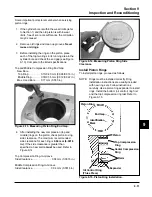
9.1
Section 9
Inspection and Reconditioning
9
Section 9
Inspection and Reconditioning
SV470-600
This section covers the operation, inspection, and repair/reconditioning of major internal engine components. The
following components are not covered in this section. They are covered in sections of their own:
Air Cleaner, Section 4
Carburetor & External Governor, Section 5
Ignition, Charging & Electric Starter, Section 7
Clean all parts thoroughly. Only clean parts can be accurately inspected and gauged for wear or damage. There
are many commercially available cleaners that will quickly remove grease, oil, and grime from engine parts. When
such a cleaner is used, follow the manufacturers instructions and safety precautions carefully. Use gasket
remover to remove old material from the valve cover, cylinder head, crankcase, and oil pan. Do not scrape the
gasket surfaces, as this could cause damage that results in leaks.
Make sure all traces of cleaning solvents are removed before the engine is reassembled and placed into
operation. Even small amounts of these cleaners can quickly break down the lubricating properties of engine oil.
Refer to A Guide to Engine Rebuilding (TP-2150) for additional information. Measurement Guide (TP-2159-A) and
Engine Inspection Data Record (TP-2435) are also available; use these to record inspection results.
Automatic Compression Release (ACR)
This engine is equipped with an Automatic
Compression Release (ACR) mechanism. The ACR
lowers compression at cranking speeds to make
starting easier.
Operation
The ACR mechanism consists of an actuating spring
and a pivoting flyweight/control pin assembly, located
in the exhaust side cam gear. A thrust washer and
mounting of the closure plate hold the ACR in position.
See Figure 9-1. At cranking speeds (700 RPM or
lower), the spring holds the flyweight in and the
rounded surface of the control pin protrudes above
the exhaust cam lobe. This pushes the exhaust valve
off its seat during the first part of the compression
stroke. The compression is reduced to an effective
ratio of about 2:1 during cranking.
After starting, when engine speed exceeds 700 RPM,
centrifugal force overcomes the force of the flyweight
spring. The flyweight moves outward, rotating the
control pin to expose the flat surface, which is lower
than the cam lobe. The control pin no longer has any
effect on the exhaust valve, and the engine operates at
full power.
When the engine is stopped, the spring returns the
flyweight/control pin assembly to the compression
release position, ready for the next start.
Figure 9-1. ACR Details.
Flyweight
Spring
Cam Lobe
Control Pin
Lower Section
Thrust Washer
Cam Gear
Summary of Contents for Kohler SV470
Page 1: ...Workshop manual Kohler Courage Tractor Engines English ...
Page 3: ......
Page 17: ...1 14 Section 1 Safety and General Information ...
Page 43: ...5 16 Section 5 Fuel System and Governor ...
Page 93: ...9 14 Section 9 Inspection and Reconditioning ...
Page 116: ...2004W27 114 03 04 26 ...
















































